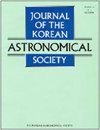Diffusive Shock Acceleration by Multiple Weak Shocks
IF 0.8
4区 物理与天体物理
Q3 ASTRONOMY & ASTROPHYSICS
引用次数: 3
Abstract
The intracluster medium (ICM) is expected to experience on average about three passages of weak shocks with low sonic Mach numbers, M ≲ 3, during the formation of galaxy clusters. Both protons and electrons could be accelerated to become high energy cosmic rays (CRs) at such ICM shocks via diffusive shock acceleration (DSA). We examine the effects of DSA by multiple shocks on the spectrum of accelerated CRs by including in situ injection/acceleration at each shock, followed by repeated re-acceleration at successive shocks in the test-particle regime. For simplicity, the accelerated particles are assumed to undergo adiabatic decompression without energy loss and escape from the system, before they encounter subsequent shocks. We show that in general the CR spectrum is flattened by multiple shock passages, compared to a single episode of DSA, and that the acceleration efficiency increases with successive shock passages. However, the decompression due to the expansion of shocks into the cluster outskirts may reduce the amplification and flattening of the CR spectrum by multiple shock passages. The final CR spectrum behind the last shock is determined by the accumulated effects of repeated re-acceleration by all previous shocks, but it is relatively insensitive to the ordering of the shock Mach numbers. Thus multiple passages of shocks may cause the slope of the CR spectrum to deviate from the canonical DSA power-law slope of the current shock.多重弱冲击的扩散冲击加速度
在星系团的形成过程中,星系团内介质(ICM)平均要经历三次低音速马赫数(M > 3)的弱激波。质子和电子都可以通过扩散激波加速(DSA)在这种ICM激波中加速成为高能宇宙射线(CRs)。我们研究了多重冲击对加速cr谱的DSA影响,包括每次冲击时的原位注射/加速,然后在测试颗粒状态下的连续冲击下重复重新加速。为简单起见,假设加速粒子在遇到后续冲击之前经历绝热减压而没有能量损失并逃离系统。研究表明,与单次DSA相比,在一般情况下,多次冲击通道使CR谱变平,并且随着连续的冲击通道加速效率增加。然而,由于激波向星团外围扩展而产生的减压可能会减少多个激波通道对CR谱的放大和平坦化。最后一次激波后的最终CR谱是由所有以前的激波重复再加速的累积效应决定的,但它对激波马赫数的顺序相对不敏感。因此,多次冲击通道可能导致CR谱的斜率偏离当前冲击的标准DSA幂律斜率。
本文章由计算机程序翻译,如有差异,请以英文原文为准。
求助全文
约1分钟内获得全文
求助全文
来源期刊

Journal of the Korean Astronomical Society
地学天文-天文与天体物理
CiteScore
1.30
自引率
10.00%
发文量
0
审稿时长
>12 weeks
期刊介绍:
JKAS is an international scientific journal publishing papers in all fields of astronomy and astrophysics. All manuscripts are subject to the scrutiny of referees. Manuscripts submitted to JKAS must comply with the ethics policy of JKAS. Six regular issues are published each year on February 28, April 30, June 30, August 31, October 31, and December 31. One year''s issues compose one volume.
 求助内容:
求助内容: 应助结果提醒方式:
应助结果提醒方式:


